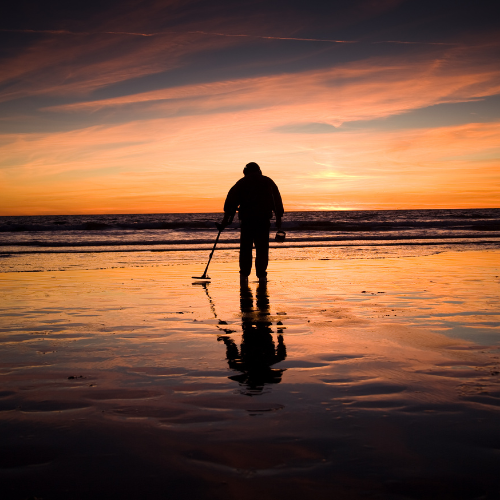Finding good spots for coins and jewelry in the wet sand and water requires a combination of understanding natural processes, knowing your detector's capabilities, and keen observation. Here are some tips to help you out:
Tidal movements:
-
Low tide: This is prime time for exploration, revealing areas usually covered by water. Look for:
- Erosion lines: These darker areas mark the high tide line and often trap objects.
- Ripples and troughs: These depressions can collect lost items washed up by waves.
- Sandbars and jetties: These structures create currents that can concentrate valuables.
-
Incoming tide: As the tide rises, it can carry objects from deeper water towards the shore. Focus on:
- Areas near the water's edge: Coins and jewelry might get deposited before being pulled back out.
- Entry and exit points: Places where people enter and leave the water are prone to dropped items.
Wet sand conditions:
- Firmness: Avoid overly spongy areas, as these likely indicate deeper water and increased mineralization, making detection harder.
- Mineralization: Saltwater and black sand can cause false signals. Focus on less mineralized areas like patches of light sand or areas near freshwater runoff.
Beach features:
- Piers and jetties: These attract crowds and can trap objects in their shadows or near their bases.
- Rock pools and crevices: These can snag lost items carried by waves.
- Areas with heavy debris: While challenging to dig, these can sometimes hide valuables amongst the clutter.
Detector settings:
- Use beach or saltwater mode: These settings adjust for the increased mineralization in wet sand and saltwater.
- Adjust sensitivity: Start with a high sensitivity and gradually lower it to minimize false signals.
- Discrimination: Use the discrimination feature to filter out unwanted ferrous objects like bottle caps.
Additional tips:
- Research the history of the area: Knowing if it was a popular beach resort in the past can increase your chances of finding older treasures.
- Observe other detectorists: See where they're searching and if they're having any luck.
- Check online forums and communities: Dedicated communities often share tips and hotspots for specific beaches.
- Remember, consistency is key: The more you practice and experiment, the better you'll understand your detector and learn to identify promising locations.
Safety precautions:
- Always be aware of your surroundings and changing tides.
- Respect local regulations and permissions for metal detecting.
- Be mindful of other beachgoers and avoid disturbing their enjoyment.
By combining these tips with your own observation and experience, you'll be well on your way to uncovering hidden treasures in the wet sand and water! Remember, patience and persistence are key, and the thrill of discovery makes every beep of your detector exciting. Good luck and happy hunting!





Leave a comment